
Gellar (27 days old) and Hamill (19 days old) are checked and weighed. Welcome to the world, little ones!
Lemurs are the planet’s most threatened group of mammals — and blue-eyed black lemurs are among the most threatened lemurs of all. At the Duke Lemur Center, we’re excited to announce that this spring, the population of these critically endangered primates has increased by an additional TWO!
Please join us in celebrating the arrivals of our newest Eulemur flavifrons infants, Hamill and Gellar!
Named after blue-eyed celebrity Mark Hamill (the famous Luke Skywalker – the Lemur Center has lots of Star Wars fans on staff!), Hamill was born on March 22 to parents West and Quinn. On March 21, West was observed acting a bit peculiar: she was snapping at members of her family group (her mate Quinn, daughter Poehler, and son Lincoln), licking her lips, and stretching out on a shelf looking uncomfortable. We suspected she might be about to start labor and moved her into her “baby suite”… and we were right! Not long after, West gave birth to a strong, healthy male infant, weighing in at a respectable 72g!

Gellar, named after blue-eyed actress Sarah Michelle, was born on March 14 to parents Wiig and Hiddleston. For their first several days, Gellar and Wiig – like all mommas and infants at the DLC – lived together in a “baby suite” separate from the other members of the family, as infant survival rates are significantly higher when mom and baby are away from the group for a few days and gradually reintroduced when the infant is less vulnerable. The family’s first all-day intro took place on March 27, and the family is doing beautifully! Gellar is climbing off of her mom a lot and starting to explore the group’s enclosure on her own, although never too far from the safety of her momma.
There are only five female blue-eyed black lemurs of breeding age in North America. Of these, four reside at the Duke Lemur Center: Margret, Wiig, West, and the DLC’s recent arrival from Madagascar, Velona. The fifth, Poots, was born at the DLC but lives at the Los Angeles Zoo with Kilmer, her dark handsome companion. Kilmer, too, resided at the DLC before traveling to Tinseltown.
While we’re elated by the births of these two blue-eyed beauties, we know it’s not enough to care for lemurs only in North Carolina. Not only does the DLC fund major conservation projects in the SAVA (northeastern) region of Madagascar, we’re also assisting Parc Ivoloina in Tamatave, Madagascar (on the island’s eastern coast) with its own blue-eyed black lemur breeding program. The DLC and Parc Ivoloina have worked together since 1987, and Parc employees have received training from DLC veterinarians and staff on-site in Madagascar as well as at the Lemur Center in Durham, NC.
Together, blue-eyed black lemurs at the DLC, Parc Ivoloina, and other institutions worldwide form a genetic safety net for their species. Each new birth helps sustain a healthy and genetically diverse population of blue-eyed black lemurs for the long-term future.
Learn more about each infant’s first weeks — and see more photos! — by clicking on the tabs below. Enjoy!
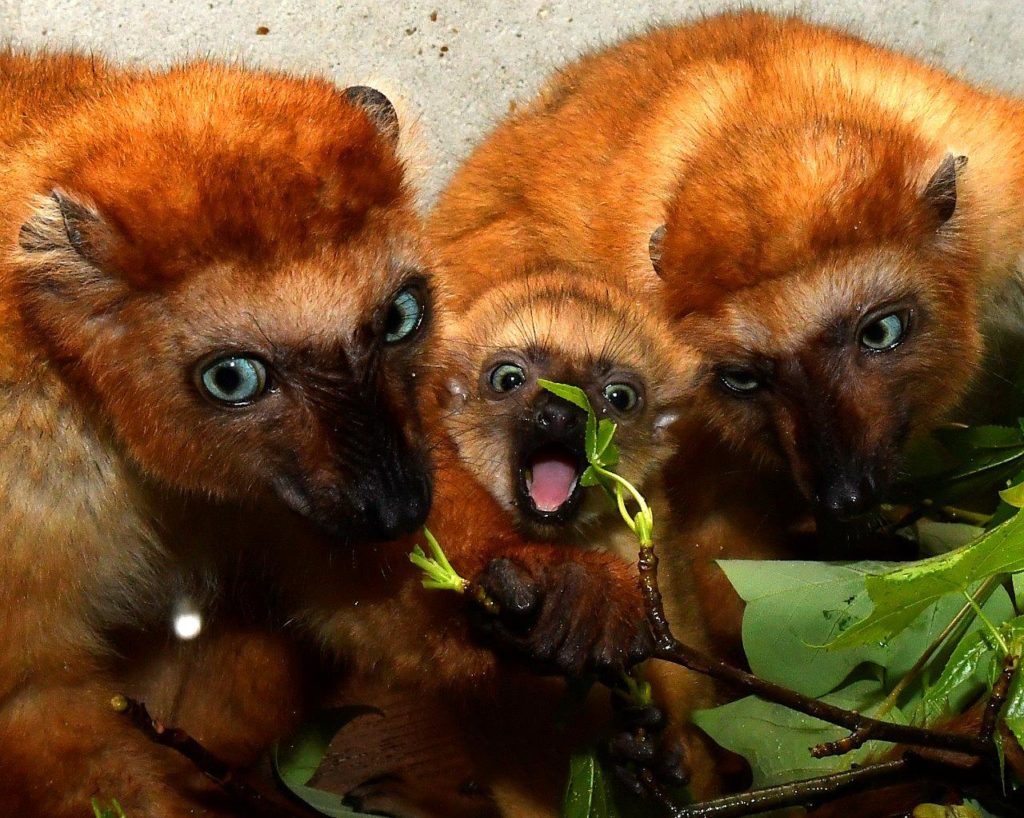
Meet Gellar! This blue-eyed girl was born on March 14, weighing in at a healthy 71g (2.5 ounces) and thriving: her weight was up to 72g on day two, and to 74g on day three! For their first several days, Gellar and her mother, Wiig – like all mommas and infants at the DLC – were separated from their family in a “baby suite,” as infant survival rates are significantly higher when mom and baby are away from the group for a few days and gradually reintroduced when the infant is less vulnerable. A wire partition between the baby suite and the enclosure shared by the rest of the family lets the mother and infant stay separate and safe, while also maintaining visual and olfactory contact with the rest of the family.
Gellar’s father, Hiddleston, and her older sister McKinnon (born March 22, 2017) were introduced to the infant for the first time on March 20. For about an hour, all four family members were together and calm, with Hiddleston maintaining a respectful distance and approaching Wiig only until she gave presumably very clear vocalizations that he should not venture any closer. McKinnon seemed to follow his lead, and she and her father sat on a branch about two feet from Wiig’s basket, where they were quiet and calm enough that all four were able to sleep. After the introduction, Hiddleston and McKinnon were shifted away from Wiig and Gellar, where they were kept separate from the mother and infant overnight.
By their third introduction (on March 22), McKinnon had become increasingly interested in her brand-new sister, especially when Gellar moved around on Wiig’s fur! Wiig was fairly tolerant of McKinnon as she tried harder to approach and investigate the infant, although she continued to keep her curious elder daughter at bay. When McKinnon got too close, Wiig would vocalize toward her and McKinnon immediately listened and backed away. Hiddleston seemed content to maintain his respectful two-foot distance.
The family’s first all-day intro took place on March 27, and the family is doing beautifully! Gellar is climbing off of her mom a lot and starting to explore the group's enclosure on her own, although never too far from her momma, Wiig.
Welcome to the world, little Gellar! We're so happy you're here!
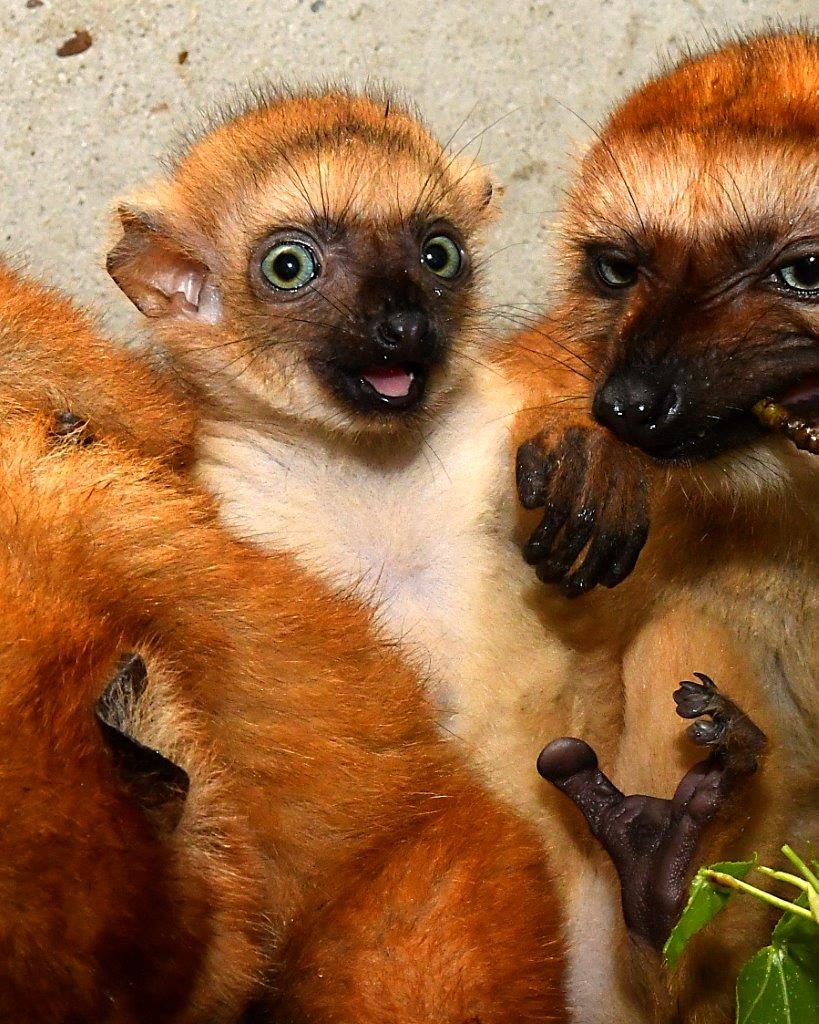
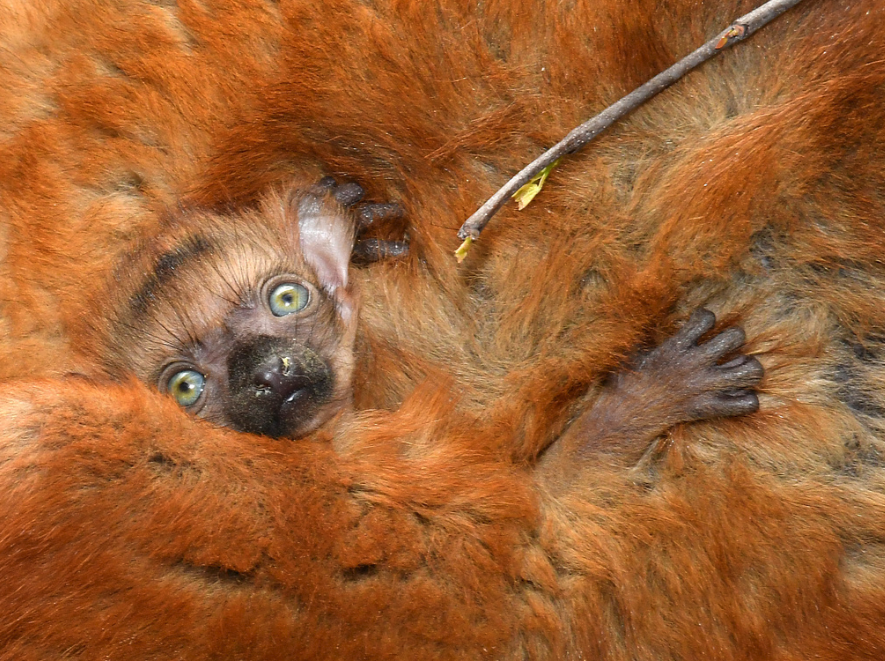
Photos by DLC photographer David Haring.
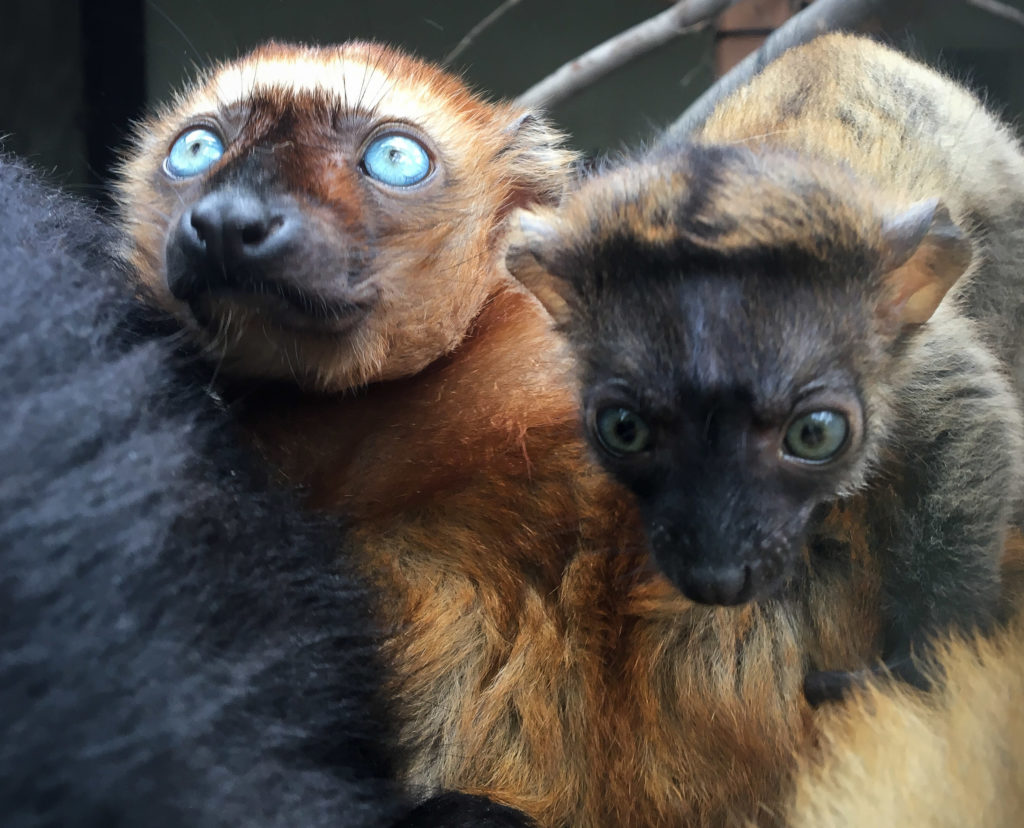
Meet Hamill! Named after blue-eyed celebrity Mark Hamill (the famous Luke Skywalker – the Lemur Center has lots of Star Wars fans on staff!), Hamill was born on March 22 to parents West and Quinn. On March 21, West was observed acting a bit peculiar: she was snapping at members of her family group (Quinn, daughter Poehler, and son Lincoln), licking her lips, and stretching out on a shelf looking uncomfortable. We suspected she might be about to start labor and moved her into her “baby suite”… and we were right! Not long after, West gave birth to a strong, healthy male infant, weighing in at a respectable 72g!
Like Wiig and Gellar (see above), West and Hamill were kept separate from Quinn, Lincoln, and Poehler for the first several days after Hamill’s birth. Their first whole-family introduction took place on March 27: there was a lot of vocalizing and scent-marking for the first 35 minutes, with the other family members wanting to be close to West – but with West herself not really wanting to have anyone near. Quinn, Poehler, and Lincoln respected her space (West is the dominant female, after all!) but stayed within a few feet, as close as West would allow.
Today, the five-lemur family is doing extremely well: Hamill is becoming increasingly active and engaged in his surroundings and has even ventured off of West – though not more than a foot away! His big brother, Lincoln (born March 29, 2016), spends lots of time near West and Hamill and grooms and plays with his infant brother regularly throughout the day. Hamill has even been observed on Lincoln, and older brother doesn’t seem to mind.
Welcome to the world, little Hamill! We’re so happy you’re here!
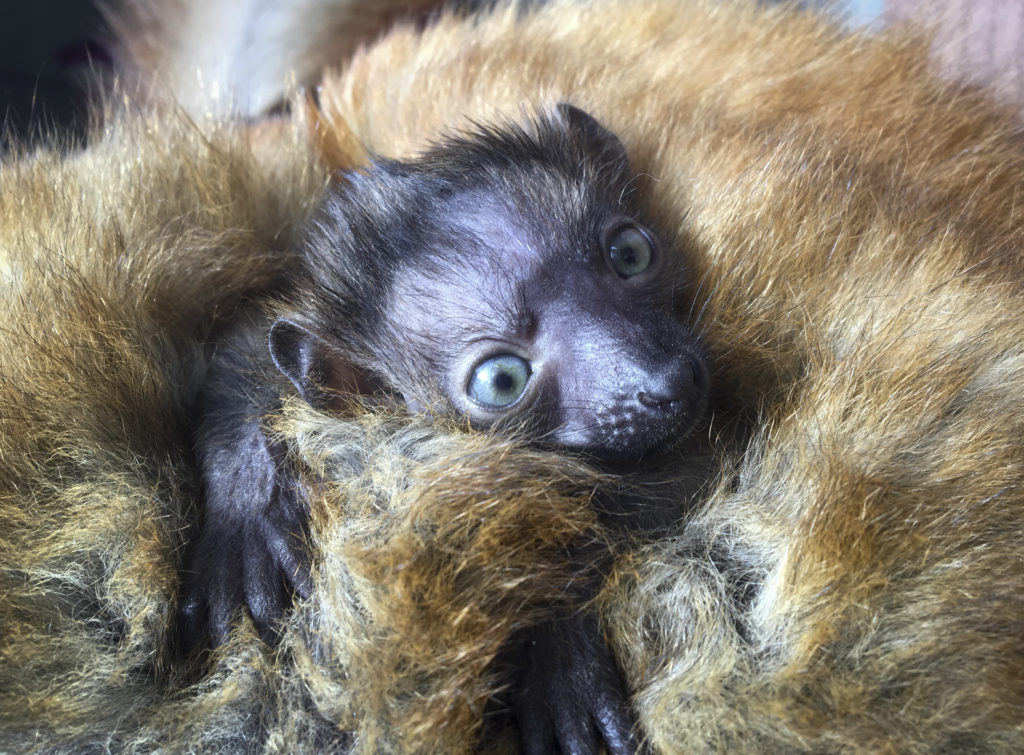
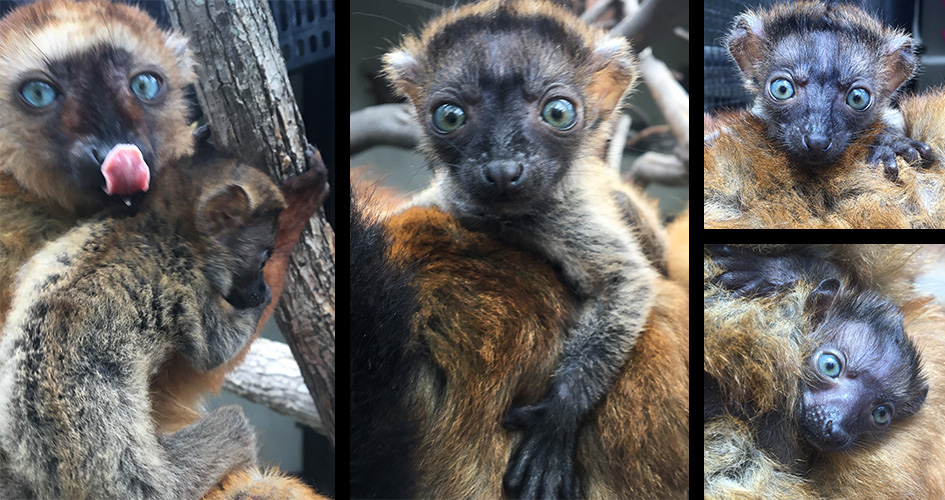
Photos by Matt Cuskelly, primary caretaker for West and her family. West isn't fond of photographers like David but trusts her caretaker Matt, and we're grateful to him for sharing his great images with us!
The blue-eyed black lemur has one of the smallest ranges of any lemur species and is protected in only a tiny area of Madagascar, Sahamalaza National Park. Sadly, because Sahamalaza is susceptible to wildfires and other pressures on the forest, the species is at risk even within the park. Those factors – a narrow geographic range, a single park protecting their natural environment, and a habitat under pressure – have resulted in blue-eyed black lemurs’ CRITICALLY ENDANGERED conservation status. In 2015, it was estimated that the blue-eyed black lemur could go extinct in the wild as little as 11 years due to habitat loss, forest fragmentation, and hunting pressures (Volameno et al.).
More great info about the blue-eyed black lemur (Eulemur flavifrons) is available on the species homepage on the DLC website. Information about our breeding program, most recent births, and the AZA’s Species Survival Plans is available here.
Want to learn even more about blue-eyed black lemurs AND help support their care, not only here but also in Madagascar? Consider symbolically adopting Presley, a male blue-eyed black lemur, through the DLC’s Adopt-A-Lemur program! Adoption packages start at just $50.
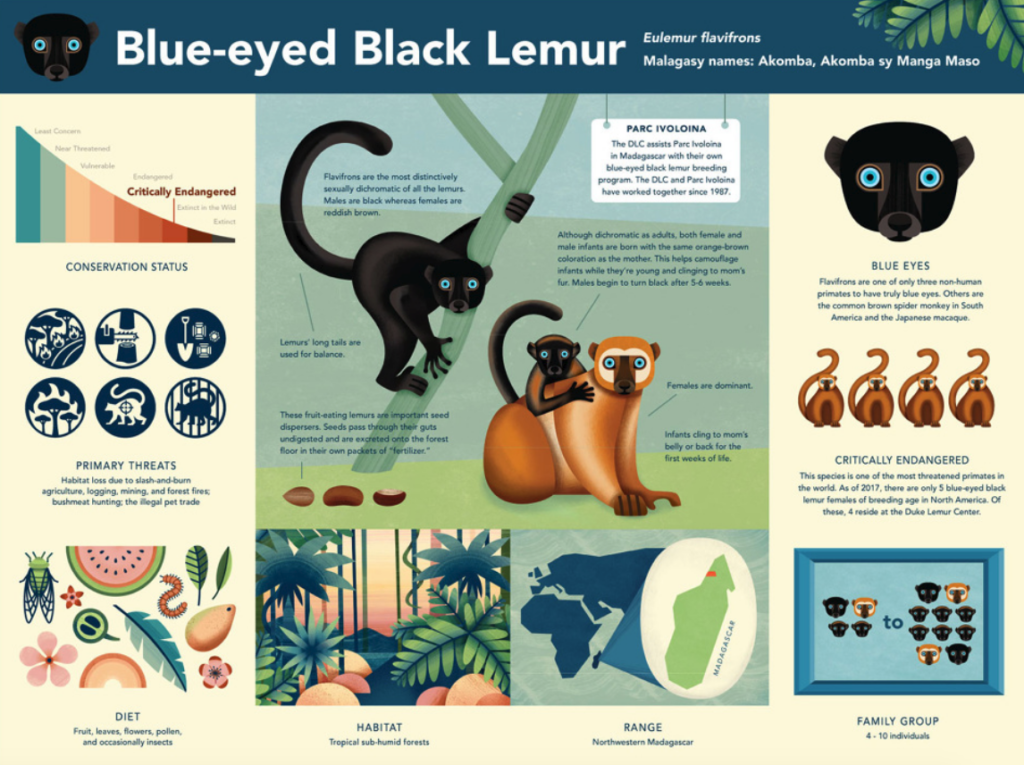
Blue-eyed black lemur infographic for the Duke Lemur Center (c) Caitlin Hansen. Click the image for a larger view.

